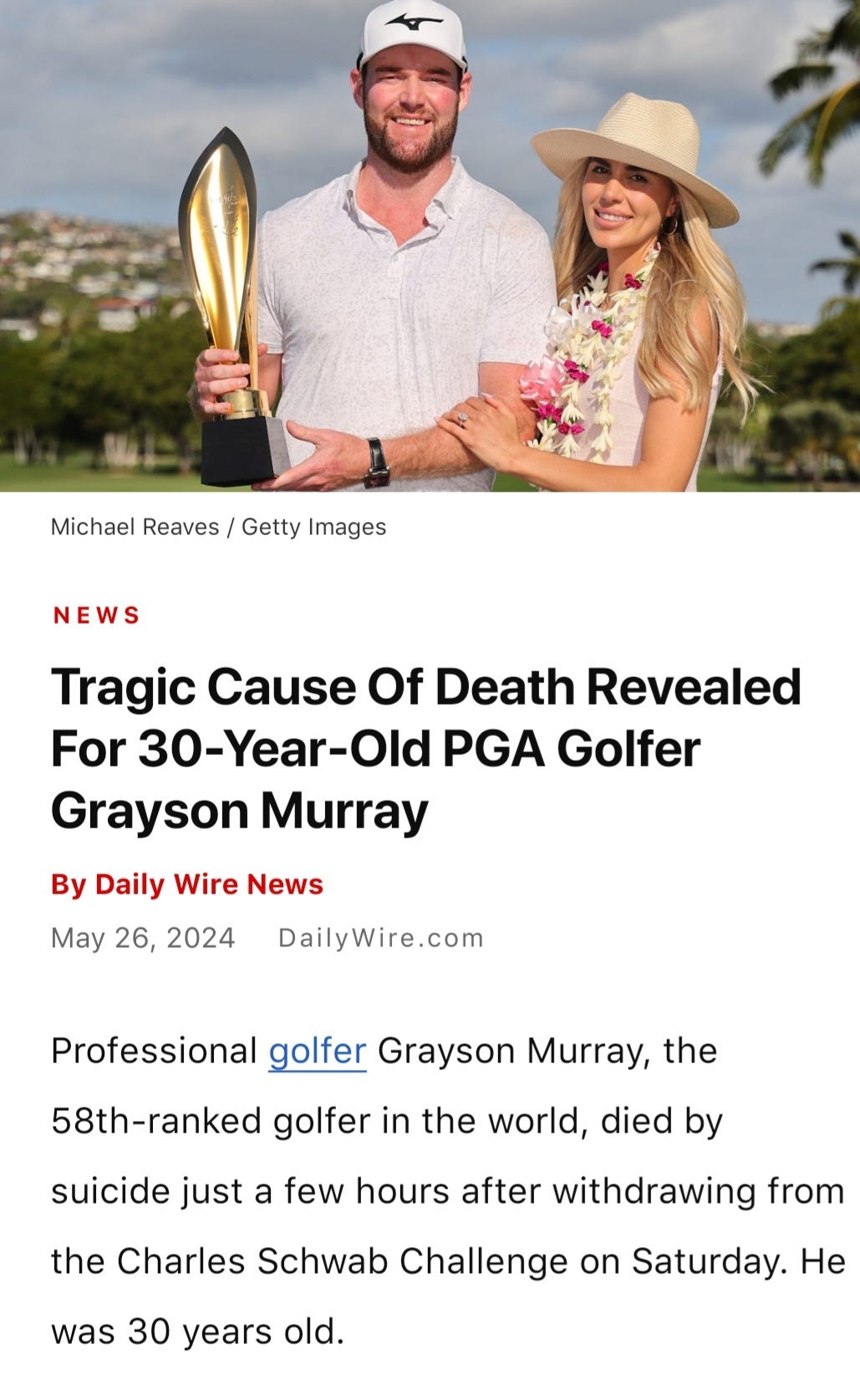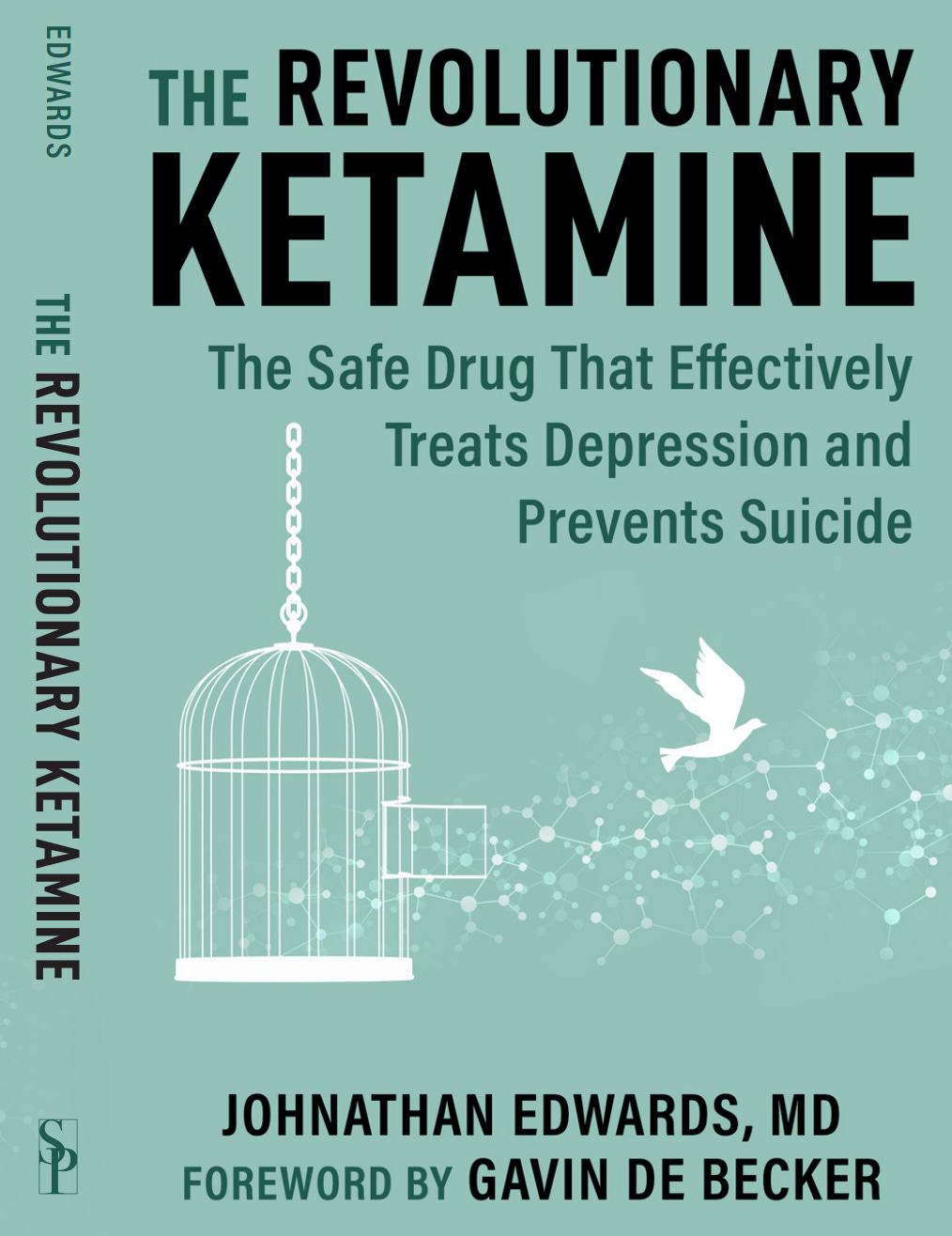Athletes, Mental Depression, and Ketamine
I was saddened by the news of another young athlete lost to suicide. The story of 30-year-old professional golfer Grayson Murray is not uncommon, unfortunately.
Grayson battled addiction, depression, and anxiety throughout his life. He ultimately took his own life shortly after withdrawing from a golf tournament. Life is the only real thing of value that we are given. Once making that fatal choice, everything slips through our fingers the moment we die. From a psychological standpoint, there's a danger zone when stopping drinking or any addictive substance.
In the same way, most suicides happen after they have gotten help and seem happiest to the world. Part of this may be from the fact that once you stop an addiction, there are feelings that happen once you "have everything figured out." Imagine a person wins the lottery, only to realize that the money didn't solve anything.
In chapter 7 of The Revolutionary Ketamine, I talk about athletes who battled depression and suicide and the change in moral attitudes that "It's OK not to be OK." I highlight how many athletes used ketamine and other psychedelics to overcome their mental anguish and suicidality.
The Revolutionary Ketamine
CHAPTER SEVEN:
ATHLETES, MENTAL ILLNESS, AND SUICIDE
“To show weakness, we’re told, in so many words, is to deserve shame. But I am here to show weakness. And I am not ashamed.” — Mardy Fish
Michael Phelps once said, “For the longest time, I thought asking for help was a sign of weakness because that’s kind of what society teaches us. Well, you know what? If someone wants to call me weak for asking for help. That’s their problem because I’m saving my own life.” Phelp’s quote accurately portrays the current state of athletic’s toward mental health.
Suicide is an important and preventable cause of death among athletes. Junior Seau, Wade Belak, and Jovan Belcher have the following in common: they all reached their dreams of becoming successful professional athletes and have ended their own lives for different reasons. Hundreds of athletes are opening up about mental illness in the NFL (football), UFC (mixed martial arts), NHL (hockey), MLB (baseball), ATP (tennis), and Olympic sports; and all sports governing bodies have recently prioritized mental health concerns for athletes. Chronic traumatic encephalopathy (CTE), depression, and suicide make headline news nowadays. Many athletes are opening up and speaking about their experiences with psychotherapy and psychedelics and how it has helped them guide their careers and lives.
ESPN commentator and journalist Kate Fagan wrote a riveting book titled, “What Made Maddy Run.” It is the story of a collegiate athlete Madison Holleran suffering from severe depression. She excelled in academics, was incredibly popular, was genuinely kind and personable, and a collegiate track athlete at the University of Pennsylvania. On January 17th, 2014, she ran off the rooftop of a parking garage near the university, and fell to her death. Holleran’s suicide rocked the University of Pennsylvania campus. In fact, in a span of 10 years, the University of Pennsylvania has recorded at least 14 student suicides, including Holleran. College counseling centers became inundated with mental health crises, and the university responded by hiring additional counselors and cutting wait times. In 2019, Gregory Eells, the head of counseling and psychological services (CAPS) at Penn, died of suicide, highlighting the complexity of the school’s continuing battle against suicide.
Mental health support is increasing in universities as there is a better sense of its importance in academia. Still, the stigma associated with mental health problems has not changed proportionately. For example, as governments and educational bodies emphasize recruiting ethnic minority students to increase diversity, yet schools may not be equipped to handle mental health challenges.
Athletes have all of those risk factors as well as living up to multiple expectations from coaches, family, friends, and sponsors. Student-athletes face unique pressures that involve balancing homework, social life, tests, vacations, relationships, and social gatherings while developing into young adults. For example, a survey of nearly 3000 students in five US universities showed that more than half experienced anxiety and depression (Zivin). Factors such as injury, failure, and drugs may lead to an increased risk of depression and suicidal behavior in anyone (Rao).
Social media is gaining even more significance among high school and college athletes with the NCAA now allowing name, image, and likeness sponsorship deals. College athletes will undoubtedly be focusing on social media more than ever before. Fagan's book highlights Madison Holleran's social media activities and her attempts to appear perfect in a world she could not control. Even the images she posted sixty minutes before jumping were filtered with an ethereal quality (Fagan). Madison's life story reveals a unique perspective on the struggles of young college student-athletes suffering from mental illness. Madison effortlessly attained perfectionism in high school but could not obtain it at an Ivy League school where she was just one of many. The pressure was too much, and she became isolated, constantly fighting her battle with depression; her story reveals today's mounting pressures of being perfect in an age of relentless connectivity and social media overload. Madison was undergoing intense therapy before her suicide; if she had been able to undergo ketamine therapy for her severe depression, could the outcome have been different?
Everyone presents an edited version of life on social media, and shared moments reflect an ideal life. If you were to look up a definition of perfection, it would state - lacking all faults or defects or satisfying all requirements. Young women growing up on Instagram spend inordinate amounts of time absorbing others' filtered images while paying less attention to the reality in front of them. Nobody posts the truth on social media; it's all smoke and mirrors. Instagram is passed off as real life, and people filter their photos, brightening their images so as not to show the sadness they might genuinely feel.
Student and athletes alike may have many Instagram friends, but all they have mastered is the art of being alone in a crowded room without considering the cost. Psychologists Jonathan Haidt and Jean Twenge have been tracking the attitudes and behaviors of teens and young adults for years (Twenge), and they believe teens spend less time nowadays with their friends in person, and more using social media and other electronic means of communication. In many classrooms, students are entirely absorbed in their smartphones, sitting in complete silence. A Journal of Adolescence article showed that in 36 out of 37 countries, loneliness at school has increased since 2012 (Twenge). Many students describe having shallow friendships and superfluous romantic relationships mediated by social media. In today’s society, we can be two feet from a friend or loved one, yet those two people may as well be two thousand miles apart, and the irony is that both parties are lonely. People often have a thousand social media friends that they’ve never actually talked to, choosing instead to bounce one-line messages hundreds of times per day. Jonathan Haidt calls this “compare and despair” - you don’t actually get social relationships; you get weak, fake social links. As Fagan says in her book, this is not friendship; this is a distraction.
The internet has addicted the world with a stimulus-response, resulting in abnormal hyperactive reactions to the excitement and adrenaline rush. The biological effects of social media addiction are real. Research has clearly shown that children who instant messaged their mothers after undergoing a stressor did not release oxytocin and had salivary cortisol levels as high as those who did not interact with their parents. In contrast, children who interacted with their mothers in person or over the phone have increased oxytocin levels and decreased cortisol levels. Messaging appears comparable with not speaking with anyone at all (seltzer). Years of research has shown that oxytocin is the brain chemical essential in neuroendocrine mechanisms for social behavior and bonding and controls emotional connections.
Universities must continue efforts at destigmatizing mental health on campuses to enable students to receive more in-campus support. Students can shield themselves from isolation by participating in athletic and group activities such as club and collegiate sports, and such activities can act as protective factors against depression. Students should use social media to stay in touch and interact with friends, family, and communities, not aim for perfection or a stage performance. Therefore, universities must allocate more resources to understanding the dangers of social media as well as support sporting and social activities that can impact students' mental health (Mofatteh).
Some athletes try to take their own lives, but the universe has other plans. One such example is the riveting story of Drew Robinson, the major league baseball player who intended to end his life by shooting himself in the head with a pistol. Miraculously, he lived through the ordeal, and is now an anti-suicide advocate saving lives. The following story is about a professional baseball player, Drew Robinson, and his attempted suicide during the lockdowns and his path to choosing life (Passan).
Mental health, suicide, and psychedelics among athletes
Athletes are imperfect role models for both physical and mental health. The term unhealthy athlete sounds a bit like a paradox. An athlete can be fit but unhealthy both physically and mentally. Clearly, athletes have lower rates of heart disease, stroke, and smoking-related cancers. Images of athletes performing portray the perception of perfect health, but internal fitness is more important than the veneer. Our culture celebrates harder, faster, stronger, and the ethos of "just play through it." Mental health is seldom spoken about in professional sports. Athletes often experience disordered eating, depression, insomnia, mood disorders, loss of motivation, reduced mental concentration, and anxiety. On the physical side, athletes often overtrain themselves. The stakes are often high, and professional and amateur athletes are not known for prioritizing their mental health. The mantra that struggling teammates are weak is common in college and professional sports. Even more, signs of mental weakness strike fear into athletes because they might not be able to do their job and risk being replaced in a highly competitive environment. Subsequently, athletes fear the stigma of "being soft." Solomon Thomas of the Las Vegas Raiders says, "It's like you are being judged for everything you do; guys are cut, traded, and signed every day. As much as you want to say it should be different, it's hard because you might open up to someone one day, and they're gone."
Although hundreds of athletes suffer from mental illness, not enough have opened up about it; some notable examples of NFL athletes who have are Darren Waller, Solomon Thomas, D.J. Chark, Demario Davis, Aaron Rodgers, A.J. Brown, Calvin Ridley, and Adam Thielen (NYTs). In professional tennis, Naomi Osaka appeared on the cover of time with the cover reading, "IT'S O.K. TO NOT, BE O.K." She opened up about her struggles with depression and anxiety before the 2021 French Open, from which she withdrew (Time, new yorker). The former US. Open champion Bianca Andreescu announced she would not compete at the Australian Open, citing depression and sadness due to the frequent lockdowns during COVID. In July 2021, Olympic gymnast Simone Bails withdrew from the finals, citing "the twisties," a heightened state of anxiety.
Many athletes, such as Michael Phelps and Terry Bradshaw, have come out after their careers about their bouts of depression and suicidality. Numerous athletes fall into depression after their careers are ended. Boxing legend Sugar Ray Leonard famously said, "Nothing could satisfy me out of the ring." Leonard's struggles with retirement and severe depression were well documented. Some professional athletes even commit suicide after their careers. One such example was professional cyclist Jonathan Cantwell.





